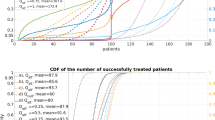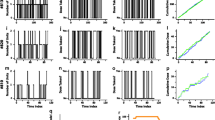Abstract
We review methods for determination of optimal dynamic treatment strategies and consider the consequences of patients missing scheduled clinic visits. We describe a Markov chain Monte Carlo procedure for parameter estimation in the presence of incomplete data. We propose an optimal dynamic fixed-dose treatment allocation rule that accommodates the possibility of patients missing future scheduled visits. We compare our strategy with a globally optimal strategy through simulations and an application on control of blood clotting time for patients on long-term anticoagulation.

Similar content being viewed by others
References
Almirall D, Ten Have T, Murphy SA (2010) Structural nested mean models for assessing time-varying effect moderation. Biometrics 66:131–139
Barrett JK, Henderson R, Rosthøj S (2013) Doubly robust estimation of optimal dynamic treatment regimes. Stat Biosci. doi:10.1007/s12561-013-9097-6
Cole SR, Frangakis CE (2009) The consistency statement in causal inference: a definition or an assumption? Epidemiology 20:3–5
Hirsh J, Dalen JE, Anderson DR, Poller L, Bussey H, Ansell J, Deykin D (2001) Oral anticoagulants: mechanism of action, clinical effectiveness, and optimal therapeutic range. Chest 119:8S–21S
Henderson R, Ansell P, Alshibani D (2010) Regret-regression for optimal dynamic treatment regimes. Biometrics 66:1192–1201
Lok JJ (2008) Statistical modeling of causal effects in continuous time. Ann Stat 36:1464–1507
Little RJA, Rubin DB (2002) Statistical analysis with missing data, 2nd edn. Wiley, New York
Moodie EMM, Richardson TS, Stephens DA (2007) Demystifying optimal dynamic treatment regimes. Biometrics 63:447–455
Murphy SA (2003) Optimal dynamic treatment regimes. J R Stat Soc Ser B 65:331–355
Orellana L, Rotnitzky A, Robins JM (2010) Dynamic regime marginal structural mean models for estimation of optimal dynamic treatment regimes, part I: main content. Int J Biostat 2:1–47
Pearl J (2009) Causality: models, reasoning and inference, 2nd edn. Cambridge University Press, Cambridge
Petersen ML, Deeks SG, Martin JN, van der Laan MJ (2007) History-adjusted marginal structural models for estimating time-varying effect modification. Am J Epidemiol 166(9):985–993
Robert C, Casella G (2004) Monte Carlo statistical methods, 2nd edn. Springer, New York
Robins JM (1994) Correcting for non-compliance in randomized trials using structural nested mean models. Commun Stat, Theory Methods 23:2379–2412
Robins JM, Rotnitzky A, Zhao LP (1994) Estimation of regression coefficients when some regressors are not always observed. J Am Stat Assoc 89:846–866
Robins JM (1997) Causal inference from complex longitudinal data. In: Berkane M (ed) Latent variable modeling and applications to causality. Springer, New York, pp 69–117
Robins JM (2004) Optimal structural nested models for optimal sequential decisions. In: Lin DY, Heagerty P (eds) Proceedings of the second symposium on biostatistics. Springer, New York, pp 189–326
Robins JM, Hernán MA, Rotnitzky A (2007) Invited commentary: effect modification by time-varying covariates. Am J Econ 166:994–1002
Robins JM, Orellana L, Rotnitzky A (2008) Estimation and extrapolation of optimal treatment and testing strategies. Stat Med 27:4678–4721
Rosendaal FR, Cannegieter SC, Van Der Meer FJ, Briët E et al. (1993) A method to determine the optimal intensity or oral anticoagulant therapy. Thromb Haemost 69:236–239
Rosthøj S, Fullwood C, Henderson R, Stewart S (2006) Estimation of optimal dynamic anticoagulation regimes from observational data: a regret-based approach. Stat Med 25:4197–4215
Rosthøj S, Keiding N, Schmiegelow K (2012) Estimation of dynamic treatment strategies for maintenance therapy of children with acute lymphoblastic leukemia: an application of history-adjusted marginal structural models. Stat Med 31:470–488
Rubin DB (1978) Bayesian inference for causal effects: the role of randomization. Ann Stat 6:34–58
Schafer JL (1997) Analysis of incomplete multivariate data. Chapman & Hall, London
van der Laan MJ, Petersen ML, Joffe MM (2005) History-adjusted marginal structural models and statically-optimal dynamic treatment regimens. Int J Biostat 1:Article 4
Welch PD, Heidelberger P (1983) Simulation run length control in presence of an initial transient. Oper Res 31:1109–1144
Zhang B, Tsiatis AA, Laber EB, Davidian M (2012) A robust method for estimating optimal treatment regimes. Biometrics 68:1010–1018
Acknowledgements
S.R. was supported by Public Health Services Grant 5 R01 CA 54706-11 from the National Cancer Institute. J.B. was supported by the Medical Research Council Grant number G0902100 We thank Riema Ali, Department of Biostatistics, University of Copenhagen, for assistance with the simulation studies. We are grateful for the helpful comments of two anonymous referees.
Author information
Authors and Affiliations
Corresponding author
Appendix
Appendix
To simplify notation, we will in the following supress the dependence of the OD and the ODFD strategy on the state history and parameters, writing \(d^{\mathrm{OD}}_{j}(A_{j-1})\) and \(d_{j}^{\mathrm{ODFD}}(A_{j-1})\) instead of \(d_{j}^{\mathrm{OD}}(\bar{S}_{j},\bar{A}_{j-1};\psi)\) and \(d_{j}^{\mathrm{ODFD}}(\bar{S}_{j},\bar{A}_{j-1};\psi)\), respectively.
At the third time point, the OD and the ODFD strategy are equal, \(d_{3}^{\mathrm{ODFD}}=d_{3}^{\mathrm{OD}}\), such that the fixed-dose contrast at time point 3 can be written
In the calculation of the expected future regrets at time point 1 and 2 we need the conditional moments of the states,
At the second time point, we need the expected future regret at time point 3, assuming the same dose is assigned at time point 2 and 3. The difference of the expected regrets assigning unchanged dose A 1 versus new dose a 2 is
The second term on the right hand side of the above equation can be written
Similarly the third term can be written
The fixed-dose contrast at the second time point is
since the regrets μ 2 and μ 3 share parameters and only depend on current and previous state and previous dose. Now adding the above terms we obtain
with
such that the first term f 1 does not depend on the observed history \((\bar{S}_{2},A_{1})\) whereas the second term f 2 is linear in history. Here
Defining ϕ j0=f 1(ψ,θ), ϕ j1=f 3(ψ,θ)/η 1, ϕ j2=f 4(ψ,θ)/η 1, ϕ j3=ψ 3/η 1 and ϕ j4=ψ 4/η 1 we can write the fixed-dose contrast on the claimed form, namely
such that the optimal dynamic fixed-dose strategy at the second time point is linear in the same terms as the optimal dynamic strategy. The parameters are different and there is an intercept term. For the parameters in the simulation study we find ϕ 20=10, ϕ 21=0, ϕ 22=0.595, ϕ 23=0.075 and ϕ 24=−0.1.
Similar calculations for the first time point give
with ϕ 10=32.2725, ϕ 11=0 and ϕ 12=0.4165 for the chosen parameter values.
Rights and permissions
About this article
Cite this article
Rosthøj, S., Henderson, R. & Barrett, J.K. Optimal Dynamic Treatment Strategies with Protection Against Missed Decision Points. Stat Biosci 6, 261–289 (2014). https://doi.org/10.1007/s12561-013-9107-8
Received:
Accepted:
Published:
Issue Date:
DOI: https://doi.org/10.1007/s12561-013-9107-8




